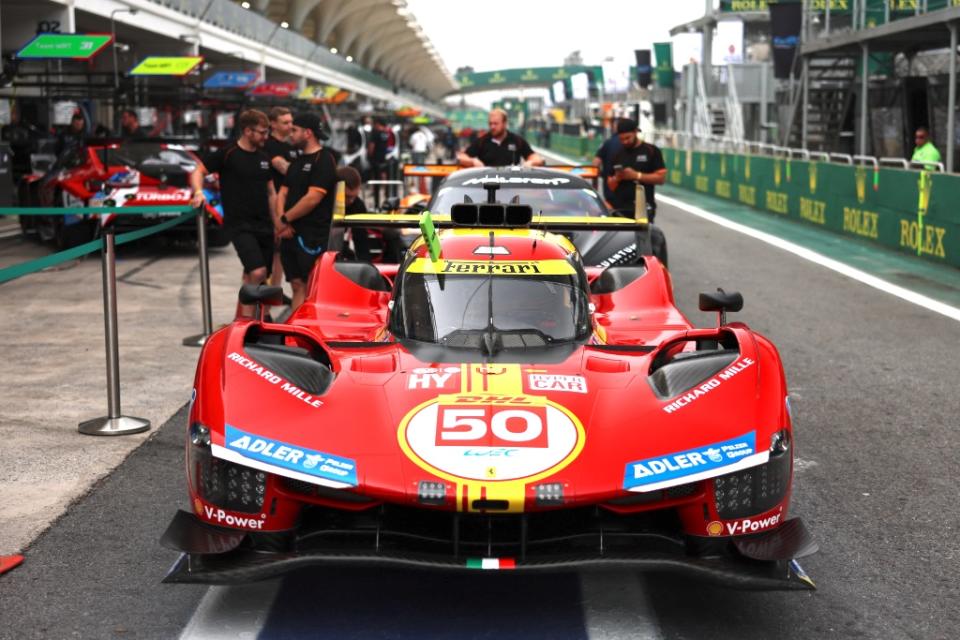Ferrari ‘Joker’ updates target better balance and consistency

Fresh from its second overall victory at the Le Mans 24 Hours in two years with the 499P, Ferrari is hungry for more success. This weekend at Interlagos it is debuting the first “Joker” upgrades for its Hypercar challenger, in an attempt to improve its form in FIA WEC races outside of Le Mans going forward and in the process, boost its title chances.
Remarkably, despite winning at La Sarthe in 2023 and ’24, the 499P is still winless at the other stops on the calendar. As such, its next target is to start winning races more regularly and clinch both the WEC Hypercar drivers’ and manufacturers’ crowns for the first time.
The modifications for this weekend’s race include a redesign of the brake cooling ducts to alter the flow distribution and ensure better cooling efficiency, and a “flick” under the front headlamps to help the aero balance.
These, according to Ferdinando Cannizzo, Ferrari’s head of endurance race cars, are relatively “minor” changes in the scheme of things, which count as a single Joker. But if Ferrari has got its sums right, these tweaks will help optimize the car’s consistency at circuits that are hard on brakes such as Imola, Fuji and Bahrain.
With the WEC Hypercar formula governed by Balance of Performance, the manufacturers in play need to look beyond pure single lap pace to make marginal gains. For a factory like Ferrari — which is already winning big races — there is no reason to target upgrades that boost peak performance. Instead, it is focused on taking steps forward in reliability and consistency.
“At the front (end of the car), we were pretty healthy (with braking performance), the limitation was at the rear,” Cannizzo explained, revealing that the changes affect the rear brakes. “These cars are sensitive to modification and this changed the overall balance of the car, so we have readjusted it. We touched the floor and the upper body, to adjust the aero balance. The most visible changes are the front ‘flicks.’
“We are working on efficiency, not making us compromise on setup choice. As long as you bring the car back in the same position in the performance windows, we do not expect changes in peak performance.
“This (Joker) one will not change that much but we may have some advantages, maybe in removing some constraints on setup — not at all the tracks, but some specific tracks.”
The timing of this Joker package might seem curious. Why introduce these changes immediately after winning Le Mans? The calendar structure and the rules surrounding Hypercar upgrades provide the answer. To gain permission from the rule-makers to change the 499P in time for Le Mans, Ferrari needed to be ready to compete with the upgrades for the second round of the season at Imola — like Peugeot, which brought its new-look 9X8 to Italy.
This is because the rule-makers require manufacturers to complete two rounds with any significant new updates before Le Mans, to avoid disrupting the BoP process for the most important event of the year. The 6 Hours of Imola came too soon. Track testing for these new components began in April at Paul Ricard, the same month as the race.
“There were no reasons to push for this (to be introduced at the start of the season) because Le Mans is not stressful for brakes,” noted Cannizzo. “So we said, ‘Let’s start here (in Brazil) and see if we can gain experience so that it will be better when we race on tracks that are really stressful on brakes, like Fuji or Bahrain.’
“The championship (in a wider sense) is one of the reasons we have introduced it now,” he continued. “As long as we had this improvement in the pocket, why not start immediately? It gave us the possibility to get familiar with this modification. We have tested but not on every track, so we need to learn more and the sooner the better.”
Development work is already underway for additional updates too.
“We are already working on improving,” Cannizzo revealed. “I will say that we are very prudent and cautious to change things on the car. We would like to understand first whether we really need something, but this is not impeding us to try to find areas to improve the car.
“This work is going on; when we will arrive with something new I don’t know. We need to take into consideration that as long as the car will still be quite competitive, it will be the FIA that approves our changes.
“Our job to improve the car will never stop. The point is we need to decide the right moments to bring modifications.”

 Yahoo Autos
Yahoo Autos 

